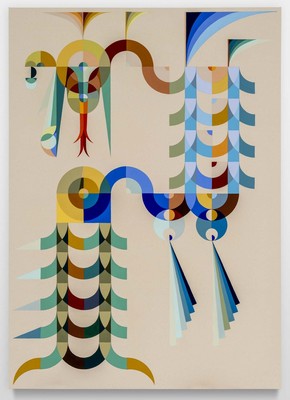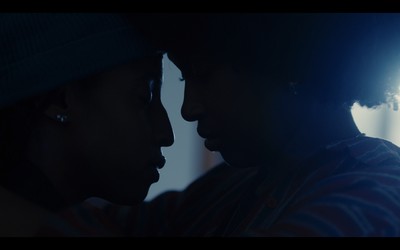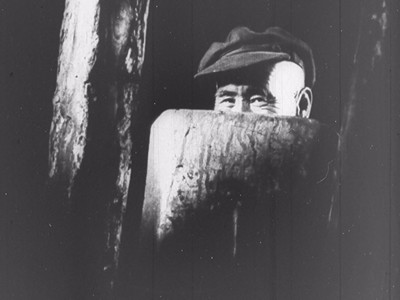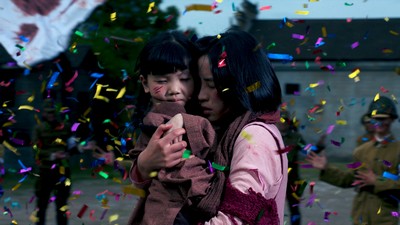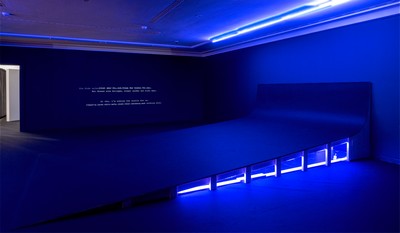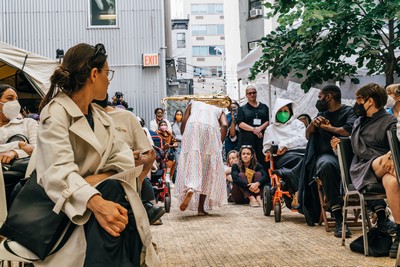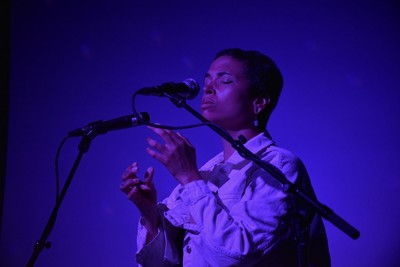Whitney Biennial 2024: Even Better Than the Real Thing
Whitney Museum of American Art, New York
March 20 – August 11, 2024
Black Cross II, 2020–21
Oil and mixed media on canvas
90 3/8 × 72 1/4 × 2 3/4 in. (229.6 × 183.5 × 7 cm)
© Harmony Hammond.
Courtesy the artist and Alexander Gray Associates, New York
Photograph by Eric Swanson
Self Portrait–She Now Calls Herself Sahara
(from the series Two Deserts,Three Winters), c. 1990s
Acrylic paint on canvas, 81 × 138 in. (205.7 × 350.5 cm).
Collection of the artist
Courtesy Jenkins Johnson Gallery, New York and San Francisco
© Mary Lovelace O'Neal
Talking Shit with Viracocha's Rainbow (Iteration I), 2023
Mineral paint and Flashe on canvas,
72 x 72 in. (182.9 x 182.9 cm).
Collection of Dr. and Mrs. Jeremy Finkelstein, Houston, TX
© Eamon Ore-Giron, 2024.
Courtesy the artist and James Cohan, New York
Photo Charles White / JWPictures.com
Still from Remembrance: A Portrait Study, 1967
16mm film transferred to video, color, sound; 5:36 min
Whitney Museum of American Art, New York
Purchase, with funds from the Film and Video Committee 2021.86
© The New American Cinema Group, Inc./The Film-Makers' Cooperative
Still from distance, 2022
Video, color, sound; 6 min
© Sydney Frances Pascal
The Past Awaiting the Future/Arrival of Drummers, 2023
Oil on linen, 99 1/2 × 151 1/2 × 2 1/2 in. (252.7 × 384.8 × 6.4 cm)
Collection of the artist
© Maja Ruznic. Courtesy Karma
Photograph by Brad Trone
Still from Artificial, 2023
Digital video, color, sound; 12 min
© Chanelle Tyson. Courtesy the artist
Still from Nuudelch Khand’laga’ (Nomadtitude), 2021
Video, black and white, sound; 6 min
© Zulaa Urchuud. Courtesy the artist
Issue, 2023
Oil on canvas, 42 × 50 in. (106.7 × 127 cm)
Collection of the artist; courtesy Ortuzar Projects, New York
© Takako Yamaguchi. Photograph by Gene Ogami
Whitney Biennial 2024: Even Better Than the Real Thing features the work of 71 artists and collectives, working across media and disciplines, representing evolving notions of American art. The 2024 Biennial marks the 81st edition of the Museum’s landmark exhibition series, the longest-running survey of American art, and addresses many of the most relevant ideas of our time.
Organized thematically, the exhibition presents artwork across most of the Museum’s gallery spaces and through a robust series of film and performance programs available at the Museum and online. The 2024 Biennial focuses on notions of “the real.” This examination of reality is highlighted through various throughlines and connections between artists, material, and ideas and acknowledges that today, society is at a critical inflection point. This apex has been brought on by the introduction of machine learning models to daily life and media, including the use of artificial intelligence, and society’s complex relationship to the body, the fluidity of identity, and the precariousness of the natural world.
Whitney Biennial 2024 co-organizers Chrissie Iles and Meg Onli began the process of building this Biennial in 2022 by meeting with and listening to artists from across the country and around the world. These artists reflected on their present moment and where their creative practices stood in a world still recovering from the COVID-19 pandemic. During this listening tour, artist Ligia Lewis identified that she and many of her peers were trying to create, through their work, a “dissonant chorus” of different ideas in a fractured time. One of the greatest challenges Lewis identified within her peer group and society at large is how to meet one another in the face of differences—differences in geography, identity, history, and lived experience. Iles and Onli examined this notion of what it means to be different and congregate together and found it resonated not only with the present but also with the framework of the Whitney Biennial.
The subtitle of this Biennial, Even Better Than the Real Thing, reflects discussions Iles and Onli had with artists about ideas of reality and combats rhetoric around “authenticity” that is used to perpetuate transphobia and restrict body autonomy in the United States. While developing this Biennial, sweeping legal changes, from the overturning of Roe v. Wade to attacks on gender-affirming care, occurred. The exhibition title responds to these developments and draws allusions to the long history of deeming people of marginalized race, gender, and ability as less than real. Iles and Onli’s curatorial process and the artworks featured are animated by these unfolding histories and the techniques that artists use to confront them, from the use of unstable materials to subversive humor, expressive abstraction, and non-Western forms of cosmological thinking.
WHITNEY BIENNIAL 2024: Even Better Than the Real Thing — Exhibition Overview and Select Works
Whitney Biennial 2024: Even Better Than the Real Thing presents the work of a multigenerational group of 71 artists and collectives working across media and disciplines to examine various throughlines that reflect the precarity of the past two years. The exhibition questions contemporary notions of reality and authenticity and acknowledges that society is at a critical inflection point influenced by the past, salient to the present, and imperative to the future.
The 2024 Whitney Biennial examines rapidly advancing technologies and machine learning tools. Artists Holly Herndon and Mat Dryhurst present work that is part of a project focused on training the data behind AI models, with the hope that AI can be used in creative, even liberating ways. Herndon and Dryhurst’s work is presented in the galleries and via a text-to-image AI program on artport, the Whitney's portal for Internet art and online gallery space for net art commissions.
The body and subjectivity as it pertains to queer identity, body sovereignty, motherhood, the aging body, and the trans body is a critical throughline of the 2024 Whitney Biennial.
Women's blueprint for survival I and II, 2022
Sun-bleached construction paper, painter's tape,
inkjet prints, two works of 47 1/2 × 36in. each (120.7 × 91.4 cm)
© Carmen Winant
Courtesy of the artist and PATRON Gallery, Chicago
Photograph by Jamie Alvarez
Carmen Winant’s work consists of 2,500 prints assembled to form a collective portrait of the ordinary, daily tasks required to provide abortion health care—a project that became much more urgent with the overturning of Roe v. Wade in 2022. In conceiving the work, Carmen Winant worked across the Midwest and the South with the archives of special collections, university hospitals, and predominantly clinics in order to collect photographs of staff, physicians, and volunteers taken over a 50-year period.
Mary Kelly is presenting part of the final project of her career at the 2024 Biennial. The work titled Lacunae (2023), meaning blank spaces or missing parts, starts with the calendar. She uses this calendar as a framework to document her own aging and the passing of friends and loved ones and invites viewers to reflect on materiality as well as the body and its final passage or transformation.
Cross Section (Right Leg Muscle III), 2023
PLA filaments, fiberglass, resin, pigment, glass
19 x 31 x 13 in. (48.26 x 78.74 x 33.02 cm)
Collection of the artist
Commissioned by M+ Museum, Hong Kong
Courtesy the artist; Empty Gallery, Hong Kong;
and Andrew Kreps Gallery, New York
Photograph by Olympia Shannon
For Jes Fan, the body is a site of making. The four sculptures presented were created from 3D-printed CAT scans of the artist’s own body. In these sculptures, injury becomes an allegory of an interior state of being, suggesting that something precious might be generated by invisible wounds borne by queer bodies and bodies of color.
On the Museum’s third floor, artist Pippa Garner presents an installation that references the ubiquity of mass-produced consumer goods and the ways that the marketing and design of these goods imply human-like qualities, such as personality and gender. The “impossible inventions” presented in the gallery adopt an almost “mad scientist” approach to the oddity of anthropomorphizing manufactured goods, imagining fantastical second lives for objects that have become obsolete. Some of the works reflect on the artist’s transition—or genderhacking, as she refers to it—which she began at the end of the 1980s.
Material agency and the use of unstable media is a throughline that several artists employ and result in some works in the 2024 Whitney Biennial changing over time.
Rag-to-Wobble, 2020
Acrylic, cotton paint cloth and vintage dress hangers
91 1/2 x 54 1/2 in. (232.4 x 138.4 cm), variable;
with 14 inches variable bulge
Courtesy the artist and Ortuzar Projects, New York
Photograph by David Kaminsky
Suzanne Jackson’s translucent paintings hang in space, suspended without canvas or visible support; the paint becomes an armature for itself. Made from acrylic paint applied in layers, each work is malleable and moves, changing shape over time.
Lotus L. Kang presents a major installation that immerses viewers in a world situated between inside and outside, life and regeneration, and emptiness and fullness, suggesting a constant state of transformation. The installation consists of photographic films unfurling from steel joists suspended from the ceiling and a series of floor sculptures made of tatami mattresses and cast aluminum objects. The materials are industrial, portable, modular, and open to change. The installation is exposed to sunlight throughout the run of the Biennial, which causes the exposed film to undergo a “tanning” process and change color. Kang likens the film surface to skin and brings the material back to ideas of the body, particularly its porous relationship with environments. By doing this, the artist hints at an unfixed understanding of one’s body, diasporic identity, and the processes of memory.
Eddie Rodolfo Aparicio presents a newly commissioned monumental sculpture made primarily with tree amber that moves over time in relation to ambient sunlight and heat. The natural materials used in this work are from trees that were imported to Southern California in the 1950s and 1960s, around the same time as many Central Americans and Mexicans were brought there to work through joint immigrant labor programs. Eventually, the city of Los Angeles began removing the trees after realizing their roots lacked space to grow along city sidewalks, which coincided with an Eisenhower-era immigration policy that began to deport many of these workers who had arrived in the United States legally. Embedded in the amber are facsimiles of archival documents from El Salvador, relating to the mass killings by the military government in the 1930s following the Indigenous rebellion of 1932. As the sculpture changes shape, the objects within it move, suggesting the ways memory and trauma are held in the body and shift over time.
Another persistent throughline in the 2024 Biennial is the psychological implications of architectural spaces and the systems of power that they represent.
Within Manhattan, 1977
Oil on canvas, 73 × 115 in. (185.4 × 292.1 cm)
Collection of Neil Lane
© Estate of Mavis Pusey. Photograph by Elon Schoenholz
The 2024 Biennial presents the work of Mavis Pusey, including works that have not been seen since the 1970s. Mavis Pusey’s work explores ideas of demolition of architecture and, specifically, demolition of buildings in NYC and the Chelsea neighborhood where Mavis Pusey lived and worked in the 1970s and 1980s, blocks away from the Whitney’s current location.
Cannupa Hanska Luger’s work takes stereotypical Native American iconography of a tipi and flips the structure upside down to celebrate Native technologies and innovations created by the artist's ancestors and upend viewers’ grounding in time and space to make way for imagined futures free of colonialism and capitalism, where broader Indigenous knowledge can thrive.
In the Museum’s ground-floor Lobby gallery, artist Ser Serpas presents sculptures made from natural materials and found objects that function as dual portraits, first of New York City, as seen through cycles of consumption and decay, and then as portraits of the artist herself through the expressive choices she has made.
The Museum’s Lobby gallery is accessible to the public free of charge as part of the Whitney Museum’s enduring commitment to supporting and showcasing the most recent work of emerging artists.
Larger histories, particularly those of non-Western communities, and how myth, cosmologies, land, water, Earth, and geological ecosystems relate are also examined in the 2024 Whitney Biennial.
Dala Nasser creates a space of reflection that intermingles history and myth, past and present, mourning, and the potential for collective mourning. This site-specific sculpture comprises a row of columns draped with bed sheets that create paintings made from charcoal rubbings of rocks found in the Adonis Cave and Temple on Mount Lebanon, north of Beirut. The sheets are then dyed with iron-rich clay from the banks of the Abraham River in Lebanon.
Rose B. Simpson’s work consists of four sculptural figures gazing at one another, creating a force field of protection and solidarity that stands in contrast to an unstable world. The work titled Daughters: Reverence (2024) conveys strength through the figures’ formal relationship with each other and through
their shared ancestry.
Five major new immersive video installations address the impact of war, dictatorships, colonialism, and the resurfacing of lost cultural histories.
Clarissa Tossin’s film Mojo’q che b’ixan ri ixkanulab’ / Antes de que los volcanes canten / Before the Volcanoes Sing (2022), a collaboration with the Maya K’iche ’Kaqchiquel poet Rosa Chávez and the Ixil Maya artist Tohil Fidel Brito Bernal, looks at ways in which contemporary Maya culture is activated by means of both reclamation and recreation. Presented nearby are 3D-printed copies of ancient Maya flutes that appear in the film.
Iolaus/In the Life (Once Again… Statues Never Die), 2022
Inkjet print, 59 × 78 3/4 in. (150 × 200 cm)
© Isaac Julien
Courtesy the artist and Victoria Miro, London
Ideas of restitution also appear in Isaac Julien’s Once Again… (Statues Never Die) (2022), a five-screen film installation that includes a display of sculptures by Richmond Barthé and 2019 Biennial artist Matthew Angelo Harrison. The installation features interwoven stories addressing the dialogue between American collector Albert C. Barnes and the Harlem Renaissance philosopher Alain Locke, as well as appearances by the poet Langston Hughes, in a critique of colonialism, cultural valuation, and queer desire.
In choreographer Ligia Lewis’s first video installation A Plot, A Scandal (2023), dancers use movement to explore histories of marronage and revenge.
Still from In Her Time (Iris’s Version), 2022–23
HD video, color, sound; 62:37 min
© Diane Severin Nguyen
Diane Severin Nguyen’s film installation In Her Time (Iris’s Version) (2023–24) depicts an actress named Iris as she rehearses for a leading role in a historical war film about the Nanjing Massacre of 1937 by the Japanese Imperial Army during the Second Sino-Japanese War (1937–45). The immersive environment, where visitors recline on a daybed in a room surrounded by pink and purple ribbons, explores the ways history circulates in the present.
Still from Too Bright to See (Part I), 2022
16mm film, color, sound; 24 min
Courtesy the artist © Madeleine Hunt-Ehrlich
Madeleine Hunt-Ehrlich’s Too Bright to See (2023–24) highlights the previously obscured life and work of Suzanne Césaire (1915–1966), the Martinican writer and feminist thinker, and a key figure in the Caribbean philosophy known as Négritude, which fused anti-colonialist policies with Surrealist aesthetics. A light installation that is fused with the moving images onscreen suggests the mercurial weather and precarity of the Caribbean.
Sonic space and the use of sound are introduced in the 2024 Whitney Biennial like never before.
In the Museum’s main staircase and large freight elevator, artist Holland Andrews composed two site-specific sound works. The work located in the stairwell consists entirely of vocal sounds that, at times, have an ambient effect and, at other times, offer a range of harmony, dissonance, and melody. The artist manipulated the sounds using a pedal-operated effects processor so that their body would be involved in the process of creation. The work meditates on the sensation of receiving information on multiple channels as if the mind were switching stations on a radio. The work located in the elevator features voice and mechanical sounds, including those made by the elevator itself, to create a restorative space. Here, Holland Andrews plays with our perceptions of the machine hum so that we might wonder if the sound is intentional or just the magic of the world, ultimately to discover that it is, in fact, both.
For the 2024 Whitney Biennial, JJJJJerome Ellis was invited to score the exhibition, responding to its sounds, artworks, and spaces to create a musical composition. The project—which offers another interpretation of the Biennial and point of entry—requires the full installation of the exhibition in order for the artist to begin, and, once complete, will exist on the gallery walls as a set of drawings and notations.
These musical scores are also inform a series of performances during the run of the show.
Call to Post (Violet) and All the Time, 2019 and 2021
(installation view, Helmhaus, Zurich, 2021).
Plywood, two-channel sound at 5–20 Hertz, transducers, and wire;
two-channel overlapping open captions,
240 x 144 x 60 in. (609.6 x 365 x 152.4 cm).
Photograph by Zoe Tempest
Image courtesy the artist and Helmhaus, Zurich
Constantina Zavitsanos’s installation is composed of blue-violet light, projected captions, and a ramp that plays speech modulated with infrasonics. Each element of this environment works with and against the limits of perception. The color violet is just within the visible light spectrum, while infrasonic sound waves are frequencies below the threshold of audibility, allowing them to be felt as vibrations but not heard. As visitors interact with the work, it change the shape of the sound and vibrations, and the captions that transcribe them may also become more or less readable as visitors block the projected light. With this work, Constantina Zavitsanos seeks to make space for collective acts of sensing and feeling that highlight some joys of the cross-disability community.
Terrace Commissions — The Whitney has commissioned two artists to present work on the Museum's fifth- and sixth-floor terraces, respectively.
Torkwase Dyson’s work is described by the artist as a “monastic playground” and is meant to be activated by visitors, who are invited to touch, sit on, and experience the work in a tactile way. This prompt for engagement speaks to Torkwase Dyson's conviction that liberation can be found at every register of movement and that “freedom is an ongoing spatial question of motion and imagination.” For Torkwase Dyson, the intertwining of abstraction and Blackness is a central philosophical concern in her work and came out of an interest in public infrastructure. Torkwase Dyson’s work on the Museum's fifth floor is the first artwork presented in conjunction with the Whitney Museum’s 10-year partnership with Hyundai Motor that enables artists to test their aspirations and incubate their creativity.
Kiyan Williams’s outdoor sculpture represents the north facade of the White House and leans on one side, sinking into the floor. The sculpture is composed of earth. The artist selected this natural material for the work to reflect how the earth carries history, an idea that Kiyan Williams explores extensively in their artistic practice. In this work, the artists point to the fragility of the political foundations of the United States, while the earth’s erosion embodies a critique of institutions at a moment when they are toppling. Looking on from nearby is a smaller sculpture of celebrated trans activist Marsha P. Johnson witnessing the erosion of the White House.
Public Art — The work Stuttering Can Create Time is a public art installation presented at 95 Horatio Street, on the facade of the building across the street from the Whitney and the south end of the High Line. Created by the collective People Who Stutter Create (PWSC), this work marks the collective's first project together and activates the Whitney’s exhibition billboard as a place to publicly celebrate the transformational space of dysfluency, a term that can encompass stuttering/stammering and other communication differences such as aphasia, Tourette’s, and dysarthria.
WHITNEY BIENNIAL 2024: Even Better Than the Real Thing — Film Program
The 2024 Whitney Biennial includes a robust film program featuring 25 artists, filmmakers, and collectives whose work explores the porousness of boundaries and identities. Presented across five separate screening days at the Museum, each program was developed by guest curators Korakrit Arunanondchai, asinnajaq, Greg de Cuir Jr., and Zackary Drucker, respectively. A select number of the films featured onsite for the 2024 Biennial is also available to view online.
WHITNEY BIENNIAL 2024: Film Program Schedule:
April 12: Speaking in Camouflage: Madeleine Hunt-Ehrlich, curated by Greg de Cuir Jr.
May 3: the land wants you, curated by asinnajaq
June 21: Dear Ghost, if a memory is false does it mean it does not have real consequences?, curated by Korakrit Arunanondchai
July 12: Sis, I Don’t Know: Remembrance a Summer Flower, International Portal of Artificial Maximum Results, curated by Zackary Drucker
September 20: Speaking in Camouflage: Christopher Harris, curated by Greg de Cuir Jr.
More information about specific films, how to purchase tickets to in-person screenings, and how to view films online is available on the Museum's website.
WHITNEY BIENNIAL 2024: Even Better Than the Real Thing — Performance Program
The 2024 Whitney Biennial’s performance program highlights the work of interdisciplinary artists, composers, choreographers, and musicians, and will include 5 performances presented in the Museum’s theater. While sight tends to be the dominant sense experienced within museums, this Biennial performance program offers an alternate approach, forefronting sound. Guest curated by Taja Cheek, the performances are challenging, deliberate, and poignant, expanding on the explorations of identity, healing, autonomy, relationships to AI, and more.
playing the saxophone
at Performance Space, New York, 2023
Photograph by Annie Forrest
performing at Weirdo Night at Zebulon, Los Angeles, 2022
Image courtesy the artist. Photograph by Indra Dunis
WHITNEY BIENNIAL 2024: Performance Schedule:
April 27–28: The Long Count by Debit
June 8: Motor Tapes by Sarah Hennies
June 29–July 1: Speaker by Holland Andrews
July 20–21: FEELING$ FEELING$ FEELING$ by Alex Tatarsky
August 2–4: Offerings by JJJJJerome Ellis
Taja Cheek, also known professionally as L'Rain, is a curator and musician. She has led performance programs and MoMA PS1 and worked closely with artists to realize projects at institutions like Creative Time, Weeksville Heritage Center, and The High Line, among others. She also co-founded a DIY rehearsal and performance space in her neighborhood in Brooklyn that primarily supports independent, improvised, and experimental music.
WHITNEY BIENNIAL 2024: Catalogue — Whitney Biennial 2024: Even Better Than the Real Thing is accompanied by a 284-page exhibition catalogue published by the Whitney and distributed by Yale University Press. Edited by Chrissie Iles and Meg Onli, the catalogue features insightful essays by Iles, Onli, Eva Hayward, and Amber Jamilla Musser, along with a conversation among Iles, Onli, and Gregg
The 2024 Whitney Biennial is co-organized by Chrissie Iles, Anne and Joel Ehrenkranz Curator at the Whitney Museum of American Art, and Meg Onli, Curator-at-Large at the Whitney, with Min Sun Jeon and Beatriz Cifuentes. The performance program is organized by Iles and Onli, with guest curator Taja Cheek. The film program is organized by Iles and Onli, with guest curators Korakrit Arunanondchai, asinnajaq, Greg de Cuir Jr., and Zackary Drucker.
WHITNEY MUSEUM OF AMERICAN ART



